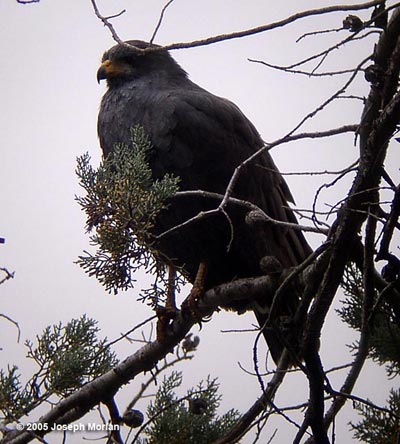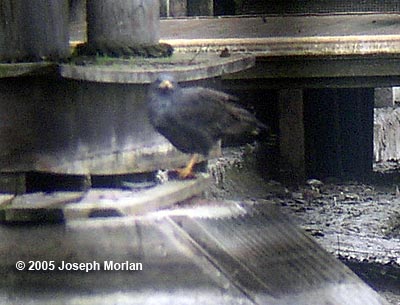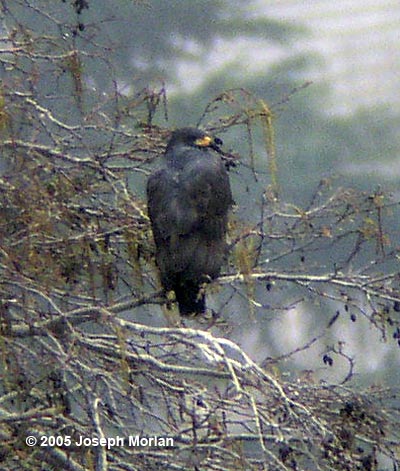Common Black-Hawk (Buteogallus
anthracinus)
Stockton, San Joaquin County, California
18 January 2005
Joseph Morlan
Photos © 18 January 2005 by Joseph Morlan. All rights reserved.
 After learning that the
Common Black-Hawk which had been seen last winter, and occasionally this winter, at Lake Lincoln in Stockton had
been seen by David Yee at nearby North Lake yesterday, I decided to visit this area in hopes of seeing the bird.
North Lake is about a quarter mile north of Lake Lincoln. It is almost completely enclosed by private homes, but
part of the lake is visible from a small park at the northeast corner of the lake, near the intersection of Fort
Donaldson Drive and Five Mile Drive.
After learning that the
Common Black-Hawk which had been seen last winter, and occasionally this winter, at Lake Lincoln in Stockton had
been seen by David Yee at nearby North Lake yesterday, I decided to visit this area in hopes of seeing the bird.
North Lake is about a quarter mile north of Lake Lincoln. It is almost completely enclosed by private homes, but
part of the lake is visible from a small park at the northeast corner of the lake, near the intersection of Fort
Donaldson Drive and Five Mile Drive.
I arrived about 8:30am and met Mike Rogers and Mike Mammoser who had been searching without success for the
previous hour. Soon the bird flew in and landed in a bare birch tree in front of a house on the east side of the
lake. It quickly flew from there to another bare tree further to the south where it was extremely difficult to
pick out from behind branches. Next it flew down to the edge of the lake and returned to a concrete embankment
with an unidentified "fish." There it held its prey in its feet as it devoured it (photo below right
taken through iron fence posts). Next it flew further away to another tree where it stayed for about an hour (photo
below left) . During this time, a number of other birders viewed the hawk through scopes. Also we shared views
of the bird with some interested neighbors. Finally the bird flew from this perch to a cypress tree fairly close
to the sidewalk where we got very good, close views for several minutes (photo upper left; larger version here;
all photos with Olympus 550z / Nikon FieldScope3ED / 30XWA / hand-held). Finally it flew towards a tall redwood
between houses on the east side and was gone from view. However I understand the bird was seen again at noon and
again in the afternoon.
Description
I spent about 2 hours with the bird. The following description is based on notes taken after seeing the bird.
A fairly large plump hawk about the size of a Red-tailed Hawk. The head and the underparts were coal-black with
bluish-gray feather-edges depending on lighting conditions. The bases of the nape feathers were tan, forming streaks
or a patch when the nape feathers were raised. The upperwings were of similar coloration, but tinged with brown
tones, particularly on the feather edges.
The lores were gray. The eyes were brown with a slight reddish cast visible only at close range. The cere and
the base of the bill were yellow, but the tip and hook of the bill were dark. The yellow extended along the broad
gape all the way under the eye, becoming white at the base. The tail was very short, extending slightly beyond
the folded wings depending on the angle. The tail was black with a broad white central band, clearly visible from
above and below, especially in flight. There was also a very narrow whitish terminal band at the very tip of the
tail. The rump and uppertail coverts were black.
The brown-tinged secondaries were very broad and formed an obvious bulge in flight. The wing tips were quite
rounded and the wings appeared to be very broad overall. When the bird preened, a whitish patch was visible at
the base of the outermost primaries on the underside of the wing. The legs and feet were quite thick-looking and
yellow in color. The claws were very long and strongly curved.
The bird called several times, a high short descending whistle reminiscent of a weak Osprey call. We were able
to watch the bird calling as it was perched.
 Discussion
Discussion
This bird was originally found and photographed February-March 2004 by Vi Strain. Her photo taken with a "point-and-shoot"
camera and digistally enlarged, is here. This season
it was first seen at Lake Lincoln on 1 October 2004 and not seen again until 17 November 2004 with another report
on 4 January 2005.
I understand (Mike Rogers pers. comm.) that the identification of this bird has been questioned by a
noted raptor expert who felt that the extensive brownish cast to the upper-wings of the bird in the published photo
by Vi Strain indicated that the bird might actually be a Mangrove Black-Hawk (Buteogallus subtilis). That
species (split from Common Black-Hawk by the AOU, but not by Howell or most other authorities) is resident in Pacific
coastal mangroves from Southern Mexico south. If the bird were a Mangrove Black-Hawk, it would certainly be of
questionable natural occurrence. However Blake (Manual of Neotropical Birds, Vol. I, 1977) indicates that Mangrove
Black-Hawk is variable in the amount of rusty on the secondaries, with less rusty in northern populations and more
in southern populations. The main distinction between Mangrove Black-Hawk and Common Black-Hawk is size, with Mangrove
being decidedly smaller as well as occupying different habitats.
Common Black-Hawk is a very rare straggler to California with only only two CBRC accepted records, both adults:
1. 13 April 1985 at Thousand Palms Oasis RIV
2. 28 March-02 May 1997 at Oasis RIV
The northern Mexican breeding populations are migratory, and there are at least 7 records from Nevada and 5
records from Colorado suggesting that this species may wander north. However, most of the Nevada and all of the
Colorado records are from Spring and Summer. A September 1978 road-kill from Minnesota has been regarded of questionable
natural occurrence.
The suburban habitat used by the Stockton bird has also been used to question its natural occurrence. However,
the species is commonly seen perched on rooftops in Mexico and commonly occurs within settled areas in that country
(Steve Howell pers. comm.). I have seen no evidence that the bird is used in Falconry.
There have been at least seven other reports of Common Black-Hawk in California that were not accepted by the
CBRC. In most cases, it was felt that the birds were probably other species. E.g. one claimed 3 Nov 2002 from Brawley
IMP almost certainly pertained to the continuing Zone-tailed Hawk known to be in the area.
 After learning that the
Common Black-Hawk which had been seen last winter, and occasionally this winter, at Lake Lincoln in Stockton had
been seen by David Yee at nearby North Lake yesterday, I decided to visit this area in hopes of seeing the bird.
North Lake is about a quarter mile north of Lake Lincoln. It is almost completely enclosed by private homes, but
part of the lake is visible from a small park at the northeast corner of the lake, near the intersection of Fort
Donaldson Drive and Five Mile Drive.
After learning that the
Common Black-Hawk which had been seen last winter, and occasionally this winter, at Lake Lincoln in Stockton had
been seen by David Yee at nearby North Lake yesterday, I decided to visit this area in hopes of seeing the bird.
North Lake is about a quarter mile north of Lake Lincoln. It is almost completely enclosed by private homes, but
part of the lake is visible from a small park at the northeast corner of the lake, near the intersection of Fort
Donaldson Drive and Five Mile Drive.
 Discussion
Discussion